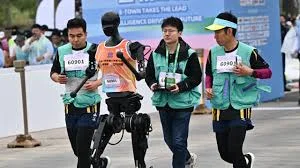For the first time, 21 humanoid robots competed in the Yizhuang Half-Marathon in Beijing on April 19, 2025, alongside 12,000 human runners. Competing robots displayed a variety of designs and capabilities from firms such as DroidUP and Noetix Robotics.
The Beijing Humanoid Robot Innovation Center alone built the full-size humanoid robot “Tiangong Ultra,” the winning runner, which finished the 21.0975-kilometer course in 2 hours, 40 minutes, and 42 seconds. Other robots required human assistance. It set a milestone and a new standard for humanoid robot athletic performance when it won the first humanoid robot half marathon championship in history.
Also Read: Nvidia introduces Groot N1, an AI model that will drive the next generation of humanoid robots
What are the challenges faced by humanoid robots during the half marathon?
The Beijing Humanoid Robot Innovation Center claims that during the half marathon, humanoid robots encountered difficulties such as prolonged running, challenging terrain, and unforeseen circumstances. This required very high levels of technology in areas such as strong motion control algorithms, efficient energy systems, robot body heat dissipation, and high-energy-density integrated joints. The bipedal robot Cassie, which resembles an ostrich but lacks an upper body, achieved a world record in 2021 by covering 5 kilometers in roughly 53 minutes.
Unique Features of “Tiangong Ultra”
“Tiangong Ultra” uses wireless navigation technology to follow and plan long-distance routes, in contrast to conventional humanoid robots that are controlled by remote handles. In order to lead the robot in target tracking, determine its position, and independently modify its running direction and speed in real-time from the start to the finish line, it used multimodal sensors and onboard motion control algorithms in conjunction with ultra-wideband wireless technology. In order to attain long endurance for prolonged operation, “Tiangong Ultra” used battery quick-swap technology during the race.
“Tiangong Ultra” weighs roughly 55 kg and is 180 cm tall. The technical challenges for humanoid robots increase exponentially with height and weight: the center of gravity rises, joint drive systems need to be able to withstand higher impacts and provide more torque, motion control algorithms need to be able to handle larger inertia and balance dynamics, and energy consumption rises sharply with the load.
“Tiangong Ultra,” with its low-inertia leg design and high-power integrated joints, showed remarkable speed. Through continuous structural optimization, “Tiangong Ultra” created a flexible-rigid coupled design for the legs and feet, balanced strength and lightweight design, and added ingenious buffering structures, allowing for long-distance running without causing structural damage. Additionally, the joints achieved thermal balance by full-body thermal simulation, joint heat dissipation technology, and optimal structure design, enabling prolonged long-duration operation.
Technology behind Tiangong Ultra
For long-distance running, a high hardware-software coupling was also essential. With the help of “Huisi Kaiwu,” a general-purpose embodied intelligence platform, “Tiangong Ultra” demonstrated distinct benefits in long-distance running by effectively coordinating its “large brain” and “small brain.” Using multimodal sensor fusion, the “large brain” side of the robot was able to dynamically change its speed and direction and comprehend its surroundings in real time, even adjusting to hazardous situations and complicated terrain. It used Beijing Humanoid Robot’s “state memory-based predictive reinforcement imitation learning” motion control technology on the “small brain” side, constantly refining its approach and adapting to new situations. This made it possible to manage synchronized joint movements with high precision, which guaranteed equilibrium when running for extended periods of time.
Also Read: New Algorithm Enables Humanoid Robots to Mimic Human Facial Expressions
In order to achieve more steady and generalized running, the robot may modify its stride and actions in real time by including disruption training for turning, slopes, and rough surfaces. The perception, decision-making, and execution loop was finished by the “Huisi Kaiwu” platform, which substantially improved the robot’s stability and dependability throughout the half marathon.
What’s the future of “Tiangong Ultra”?
The future “Tiangong,” which has been improved and is outfitted with the “Huisi Kaiwu” platform, will be able to perform a variety of skills with remarkable athleticism, natural interaction, precise task planning, and dexterous dual-arm operations. More assistance and ease for social production and everyday living will result from its broad applicability in industrial manufacture, logistics sorting, specialized operations, home services, and elder care.
In Nutshell
The “Tiangong 2.0” generation was introduced at the post-race display. “Tiangong 2.0” featured significant improvements in hardware, operational performance, and application capabilities as compared to its predecessor. Its hardware, which includes independently designed integrated joints with high torque and precision, significantly enhances athletic performance and flexibility to challenging situations.
Also Read: Tesla to Deploy Humanoid Robots by 2025, Says Elon Musk
Performance-wise, “Tiangong 2.0” is the first industrial-grade robot with continuous operating capabilities thanks to a self-developed dual-battery hot-swapping system that enables battery changes while the machine is powered on. When paired with multi-condition energy control technology, it provides significantly more endurance than the previous model. Its completely adjustable lower limb system and industrial-grade upper limb weight capacity provide a solid technical basis for challenging jobs.


















